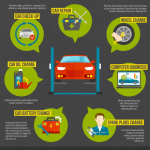Can I Drive On A Flat Tire

Driving on a flat tire is not advisable. Continuing with a deflated tire can lead to substantial vehicle damage and elevate accident risks. Upon encountering a flat tire, it’s paramount to promptly find a safe spot to halt and resolve the situation, whether by replacing the tire yourself or by calling for expert help. For a more in-depth understanding of the risks, causes, and best practices associated with flat tires, continue reading the detailed insights provided in the sections below.
Briefly discuss the common situation of getting a flat tire while driving
Getting a flat tire while driving is not only frustrating, but it can also be dangerous. It’s a situation that almost every driver has faced at least once in their lifetime. The most common causes of flat tires include punctured or damaged tires due to nails, sharp objects on the road, potholes, and worn-out treads. These unexpected situations can happen anytime and anywhere – during commuting to work or school, running errands around town or taking a long drive.
When you get a flat tire while driving, you might feel anxious and overwhelmed – this is natural! However, it’s important to remain calm and focused as your safety will depend on how well you handle the situation. Driving with a flat tire can lead to significant damage to your vehicle’s wheels, suspension system and even cause accidents resulting in injuries.
In such circumstances where there are no nearby repair shops available or if changing the tire yourself seems too daunting of task , calling for roadside assistance may be necessary . Remember that being prepared beforehand by carrying an emergency kit containing essential tools like jack stands , spare tire etc could come handy when dealing with unforseen events like getting stranded on the side of the road with a popped tyre.
It’s always best practice as soon as possible after discovering any issues pertaining to tyre deflation whilst driving or stationary promptly seek expert advice from qualified professionals who are experienced in handling such scenarios
Briefly discuss the common situation of getting a flat tire while driving
Getting a flat tire while driving is not only frustrating, but it can also be dangerous. It’s a situation that almost every driver has faced at least once in their lifetime. The most common causes of flat tires include punctured or damaged tires due to nails, sharp objects on the road, potholes, and worn-out treads. These unexpected situations can happen anytime and anywhere – during commuting to work or school, running errands around town or taking a long drive.
When you get a flat tire while driving, you might feel anxious and overwhelmed – this is natural! However, it’s important to remain calm and focused as your safety will depend on how well you handle the situation. Driving with a flat tire can lead to significant damage to your vehicle’s wheels, suspension system and even cause accidents resulting in injuries.
In such circumstances where there are no nearby repair shops available or if changing the tire yourself seems too daunting of task , calling for roadside assistance may be necessary . Remember that being prepared beforehand by carrying an emergency kit containing essential tools like jack stands , spare tire etc could come handy when dealing with unforseen events like getting stranded on the side of the road with a popped tyre.
It’s always best practice as soon as possible after discovering any issues pertaining to tyre deflation whilst driving or stationary promptly seek expert advice from qualified professionals who are experienced in handling such scenarios
Pose the question: “Can you drive on a flat tire?”
Getting a flat tire while driving can be a frustrating and stressful experience, especially if you are far from home or in an unsafe area. One of the most common questions people ask when they find themselves in this situation is whether it’s safe to continue driving on a flat tire.
The short answer is no, you should not drive on a flat tire. Doing so could cause serious damage to your vehicle and put yourself and others at risk. Driving on a flat tire can also make it difficult to steer, reduce your ability to control the car, and increase the likelihood of accidents.
If you have no other choice but to drive on a flat tire for some reason, try to keep your speed as low as possible and avoid sudden turns or maneuvers that could further damage the wheel. However, even if you manage to reach your destination safely, driving on a flat tire will likely cost more time and money in repairs than taking action immediately.
So what should you do if you get a flat? The best course of action is always to pull over to a safe location as soon as possible and assess the damage. If there’s only minor damage such as small punctures or cuts in the tread area that haven’t caused any significant wear or tear yet – then changing the tire might be an option. But before making any decisions about repairing or replacing tires altogether consult with professionals who will give advice tailored specifically for your case!
Risks of Driving on a Flat Tire
Driving on a flat tire can be extremely risky, and it’s important to understand why before even considering attempting it. For starters, driving on a flat tire can cause you to lose control of your vehicle. With no air pressure in the tire, the wheel may begin to wobble or shake, making it difficult for you to steer straight.
In addition, driving on a flat tire can cause significant damage to your car’s wheel rim which will require extensive repair or replacement costs. The weight of your vehicle will place immense pressure on the unprotected rubber surface of the tire causing further damages such as bulges that could burst if not addressed promptly.
Moreover, when driving on a flat tire at high speeds for extended periods, there is an increased risk of blowing out tires completely; this could lead to accidents and pose serious safety issues for yourself and other drivers around you.
While it may seem like driving with a punctured or deflated tire is possible under some circumstances but should always avoid doing so. It’s better safe than sorry – getting off the road immediately after detecting any problem is always recommended instead of putting yourself or others at risk by trying something dangerous like driving with a flat tyre!
Explain the dangers of driving on a flat tire, such as loss of control, damage to the wheel, and more
Driving on a flat tire can be extremely dangerous. When your car’s tire is flat, it loses its ability to support the vehicle’s weight and maintain proper contact with the road. This can lead to loss of control over your vehicle.
A flat tire also puts extra stress on other parts of your vehicle, such as the wheel and suspension system. If you continue driving on a flat tire, you risk damaging these components, which could lead to costly repairs.
Another danger of driving on a flat tire is that it increases stopping distance. You may have difficulty bringing your car to a stop in an emergency situation because the deflated tire will not grip the road properly.
In addition, driving on a flat tire can cause uneven wear and tear on your tires. It may even result in blowouts or punctures in other tires due to increased pressure.
If you experience a flat tire while driving, it is best to pull over immediately and assess the damage rather than continuing to drive. The safety risks and potential damages outweigh any benefits of trying to drive further with a damaged or deflated tire.
When It’s Safe to Drive on a Flat Tire
When faced with a flat tire, it’s important to assess the situation before deciding whether or not it’s safe to drive on it. The first thing you should do is pull over to a safe location, away from traffic.
Next, take a look at the tire and determine if there is any visible damage or if the tire has completely deflated. If the damage is minimal and only affecting the tread of the tire, then you may be able to drive on it for a short distance at low speeds.
However, if there are signs of significant damage such as large punctures or sidewall bulges, driving on the flat tire could put you in danger. In these cases, do not attempt to drive and instead call for roadside assistance immediately.
It’s also important to remember that even if your car has been equipped with run-flat tires that can still be driven on after they have lost some pressure, they still need attention as soon as possible.
Driving on a flat tire could cause irreversible damage beyond just ruining your trip plans; loss of control while driving being one potential risk. Therefore always err towards caution when assessing whether or not it’s safe enough for you to continue driving with a flat tyre
What to Do When You Get a Flat Tire
Getting a flat tire can be a frustrating and stressful situation, but knowing what to do when it happens can help ease the anxiety. The first step is to pull over to a safe location as soon as possible. This could mean finding a nearby parking lot or pulling onto the shoulder of the road, making sure that you are far enough away from traffic.
Once you have pulled over, assess the damage to your tire. If you notice any bulges or tears in the sidewall of your tire or if your rim has been damaged, it’s best not to drive on it any further. In this case, calling for assistance from a professional roadside service is recommended.
If there is only minor damage such as a small puncture in the tread area of your tire and you have access to necessary tools and spare tire kit, changing tires may be an option for those confident with doing so safely.
Before attempting any repairs yourself Always consult your Owner’s manual before attempting repairs at home if unsure about how repair works; always call for roadside assistance immediately because driving on deflated tires can cause severe damages and risks to both driver’s safety and vehicle health.
Pull over somewhere safe immediately after discovering that one or more of car’s tyres are flat; Assess tyre condition carefully – don’t drive on bulging/tearing sidewalls; Call out roadside assistance (who will fix flat tyres) or attempt changeover yourself using correct tools while following key steps mentioned in owner’s manual; remember that Safety should always come first!
Explain the steps to take when you get a flat tire, including pulling over to a safe location, assessing the damage, and either changing the tire or calling for assistance
Getting a flat tire is never a fun experience, but knowing what to do in this situation can make all the difference. Here are some steps to take when you get a flat tire:
- 1. Pull over to a safe location: As soon as you realize that your tire has gone flat, pull over to the side of the road where it’s safe and away from traffic.
- 2. Assess the damage: Once you’re safely parked, check your tire for any visible signs of damage or puncture wounds.
- 3. Decide whether to change the tire yourself or call for assistance: If you feel comfortable changing your own tire and have all the necessary tools, then go ahead and do so. However, if you’re unsure about how to change a tire or don’t have access to spare tires or tools needed for replacement, then it’s best to call for roadside assistance.
- 4. Call for Assistance: Don’t hesitate contacting an auto-repair shop or car service provider who will assist with towing services
Remember that driving on a flat tire can be incredibly dangerous and could cause further damage not only to your car but also endangering other drivers on the road; It’s important that every driver knows what steps they need if they ever find themselves with this issue in order stay safe until help arrives!
Conclusion
Driving on a flat tire is not only risky but also dangerous, and it should be avoided at all costs. Even though you may feel the urge to drive a couple of miles to get help or reach your destination, driving on a flat tire can cause irreversible damage to your wheel and suspension system.
If you find yourself in such an unfortunate situation, the best thing to do is pull over as soon as possible and assess the damage. If it’s safe to change the tire, try doing so while ensuring that you follow all safety precautions. However, if you’re unsure how to change a tire or don’t have proper equipment with you, call for roadside assistance instead.
Always ensure that your tires are properly inflated and check them regularly for any signs of wear or tear. By taking care of your vehicle’s tires, they will take care of you too by providing better handling and improved fuel efficiency while keeping you safe on the road. Remember: prevention is always better than cure!
FAQs
How long can I drive on a flat tire?
Driving on a flat tire is not recommended as it can cause irreparable damage to the tire, rim, and other parts of your car. It is generally recommended to drive no more than a few hundred yards on a flat tire to get to a safe place to change the tire.
Can I drive 10 minutes on a flat tire?
It is not recommended to drive on a flat tire for any distance, including 10 minutes. Even a short distance can cause irreversible damage to your tire and rim, and can put you and other drivers on the road at risk.
Can I drive a short distance with a flat tire?
Driving on a flat tire for a short distance is not recommended, but if it is absolutely necessary to move the car, drive at a very slow speed (less than 20 mph) and avoid turning or maneuvering as much as possible. However, it is still highly recommended to replace the flat tire with a spare tire as soon as possible.
Can I put air in a flat tire?
You can put air in a flat tire, but it is important to note that adding air to a flat tire will not fix the underlying issue that caused the tire to go flat. It is recommended to only add air to a tire temporarily to drive to a safe location where the tire can be properly repaired or replaced.




